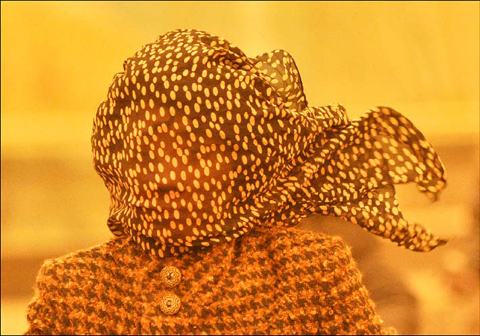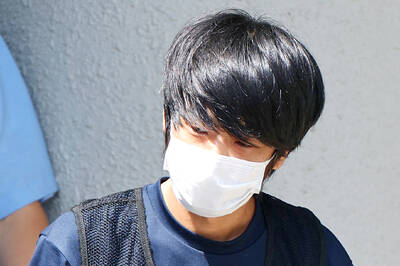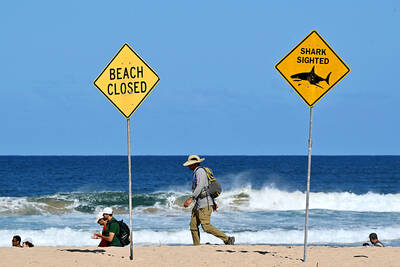China’s capital woke up to orange-tinted skies Saturday as the strongest sandstorm so far this year hit the country’s north, delaying some flights at Beijing’s airport and prompting a dust warning for Seoul.
The sky glowed and a thin film of sand covered Beijing, causing workers to muffle their faces in vast Tiananmen Square.
The city’s weather bureau gave the air quality a rare hazardous ranking.

PHOTO: REUTERS
Air quality is “very bad for the health,” China’s national weather bureau warned. It said people should cover their mouths when outside and keep doors and windows closed.
China’s expanding deserts now cover one-third of the country as a result of overgrazing, deforestation, urban sprawl and drought. The shifting sands have led to a sharp increase in sandstorms, the grit from which can travel as far as the western US.
The Chinese Academy of Sciences has estimated that the number of sandstorms has jumped six-fold in the past 50 years to around two dozen a year.
The latest sandstorm has also affected the regions of Xinjiang and Inner Mongolia and the provinces of Shanxi, Shaanxi and Hebei.
As the sandstorm moved southeast, South Korea’s national weather agency issued a yellow dust advisory for Seoul and other parts of the country. Chun Youngsin, a researcher at the Korea Meteorological Administration, said the yellow dust was expected to hit the Korean peninsula beginning yesterday afternoon and it would be “the worst yellow dust” this year.
Some flights at Beijing’s international airport were delayed but eventually took off, said a woman answering inquiries from concerned passengers on the airport hot line.
China has planted thousands of acres of vegetation in recent years in an effort to stop the spread of deserts in its north and west, but experts have said the work will take decades. China’s dust storms were at their worst in the 1950s and 1960s after campaigns to raise farm and factory output following the 1949 communist revolution stripped the soil of vegetation.
“I think this kind of natural disaster is caused by human activity, but I don’t know the exact reason, and I don’t know exactly what we can do to prevent this,” Shi Chunyan, a Beijing resident, said of yesterday’s storm.

With much pomp and circumstance, Cairo is today to inaugurate the long-awaited Grand Egyptian Museum (GEM), widely presented as the crowning jewel on authorities’ efforts to overhaul the country’s vital tourism industry. With a panoramic view of the Giza pyramids plateau, the museum houses thousands of artifacts spanning more than 5,000 years of Egyptian antiquity at a whopping cost of more than US$1 billion. More than two decades in the making, the ultra-modern museum anticipates 5 million visitors annually, with never-before-seen relics on display. In the run-up to the grand opening, Egyptian media and official statements have hailed the “historic moment,” describing the

SECRETIVE SECT: Tetsuya Yamagami was said to have held a grudge against the Unification Church for bankrupting his family after his mother donated about ¥100m The gunman accused of killing former Japanese prime minister Shinzo Abe yesterday pleaded guilty, three years after the assassination in broad daylight shocked the world. The slaying forced a reckoning in a nation with little experience of gun violence, and ignited scrutiny of alleged ties between prominent conservative lawmakers and a secretive sect, the Unification Church. “Everything is true,” Tetsuya Yamagami said at a court in the western city of Nara, admitting to murdering the nation’s longest-serving leader in July 2022. The 45-year-old was led into the room by four security officials. When the judge asked him to state his name, Yamagami, who

DEADLY PREDATORS: In New South Wales, smart drumlines — anchored buoys with baited hooks — send an alert when a shark bites, allowing the sharks to be tagged High above Sydney’s beaches, drones seek one of the world’s deadliest predators, scanning for the flick of a tail, the swish of a fin or a shadow slipping through the swell. Australia’s oceans are teeming with sharks, with great whites topping the list of species that might fatally chomp a human. Undeterred, Australians flock to the sea in huge numbers — with a survey last year showing that nearly two-thirds of the population made a total of 650 million coastal visits in a single year. Many beach lovers accept the risks. When a shark killed surfer Mercury Psillakis off a northern Sydney beach last

‘CHILD PORNOGRAPHY’: The doll on Shein’s Web site measure about 80cm in height, and it was holding a teddy bear in a photo published by a daily newspaper France’s anti-fraud unit on Saturday said it had reported Asian e-commerce giant Shein (希音) for selling what it described as “sex dolls with a childlike appearance.” The French Directorate General for Competition, Consumer Affairs and Fraud Control (DGCCRF) said in a statement that the “description and categorization” of the items on Shein’s Web site “make it difficult to doubt the child pornography nature of the content.” Shortly after the statement, Shein announced that the dolls in question had been withdrawn from its platform and that it had launched an internal inquiry. On its Web site, Le Parisien daily published a